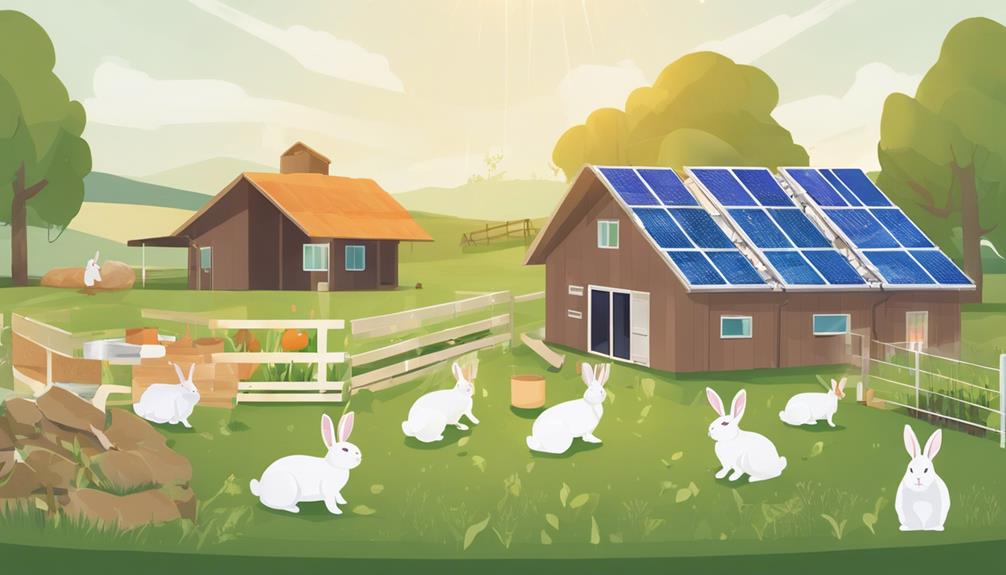Why Is Rabbit Farming Economically Beneficial?
Rabbit farming is economically beneficial due to efficient feed conversion, high reproductive rates, quick time to market, minimal space needs, low initial investment, sustainability practices, and potential for value-added products. Rabbits turn feed into body mass effectively, lowering production costs. Their quick reproduction boosts profitability. Short gestation periods mean fast market weight, maximizing returns. They thrive in high-density settings, perfect for urban environments. Starting costs are modest with high profit margins. Sustainable practices enhance reputation and reduce costs. Exploring value-added products can further increase profitability.Discover more about the economic advantages of rabbit farming.
Cost-Effective Feed Conversion
When raising rabbits, their efficient feed conversion rate contributes significantly to the cost-effectiveness of rabbit farming. Feed efficiency plays a crucial role in the economic benefits of raising rabbits. Rabbits are known for their ability to convert feed into body mass more efficiently compared to larger livestock animals like cattle or pigs. This means that for every pound of feed given to rabbits, they can produce more meat, fur, or other products, making them a cost-effective option for farmers.
The economic benefits of this feed efficiency are twofold. Firstly, it reduces the overall cost of production. Since rabbits require less feed to produce the same amount of meat compared to other livestock, farmers can save money on feed expenses. This is especially significant given that feed costs typically make up a substantial portion of the total expenses in animal farming operations.
Secondly, the efficient feed conversion rate of rabbits leads to higher profitability. With lower input costs and higher output in terms of meat or fur, farmers can increase their profit margins. This improved efficiency not only benefits the farmers directly but also contributes to the sustainability and viability of rabbit farming as a whole. In conclusion, the exceptional feed efficiency of rabbits is a key factor in the economic advantages of rabbit farming.
High Reproductive Rate
Rabbits' high reproductive rate significantly impacts the economic sustainability of rabbit farming by maximizing output potential through frequent breeding cycles. Genetic selection plays a crucial role in enhancing reproductive efficiency. Breeders focus on selecting rabbits with desirable traits that promote prolific breeding, such as high fertility rates and large litter sizes. This careful genetic selection ensures that the offspring are more likely to inherit these favorable characteristics, ultimately leading to increased productivity on the farm.
The market demand for rabbit meat and other products further underscores the importance of the high reproductive rate. With a growing interest in lean, healthy meats, rabbit meat has gained popularity among consumers. The ability to meet this demand hinges on the capacity of rabbit farmers to breed and raise rabbits efficiently. The more offspring produced per breeding cycle, the greater the potential for profit.
Profitability in rabbit farming is closely tied to the reproductive success of the breeding does. By optimizing breeding practices and ensuring that the selected breeding stock is genetically predisposed to high reproductive rates, farmers can capitalize on the market demand for rabbit products. The high reproductive rate of rabbits, coupled with effective genetic selection and breeding strategies, sets the stage for a financially rewarding venture in the rabbit farming industry.
Quick Turnaround Time to Market
Efficient breeding practices in rabbit farming facilitate a rapid turnaround time to bring products to the market, maximizing profitability. This quick turnaround time is a result of rabbits having a short gestation period of around 31 days and reaching market weight between 8-12 weeks of age. Compared to other livestock, such as cattle or pigs, which have longer gestation periods and take several months to reach market weight, rabbits offer a significant advantage in terms of speed to market. This allows rabbit farmers to capitalize on increased demand for their products promptly.
One key factor contributing to the rapid turnaround time in rabbit farming is decreased competition. While other meat sources like beef and pork dominate the market, rabbit meat is gaining popularity due to its lean protein content and health benefits. This niche market for rabbit meat means that rabbit farmers face less competition, enabling them to meet the increased demand more efficiently.
Moreover, the increased demand for rabbit products, including meat, fur, and manure, further drives the need for a quick turnaround time. With the rising interest in sustainable and eco-friendly practices, rabbit farming offers a viable solution. The ability to swiftly bring rabbit products to the market positions rabbit farming as a lucrative venture in response to consumer demands.
Minimal Space Requirements
What're the space requirements for optimal rabbit farming efficiency? When considering rabbit farming, space efficiency is a crucial factor, especially in urban farming settings where available space is limited. Unlike traditional livestock, rabbits can be raised in a relatively small area, making them an ideal choice for urban farmers looking to maximize production in limited space.
Rabbits are known for their ability to thrive in high-density conditions, requiring minimal space compared to larger livestock animals like cows or pigs. On average, a single rabbit needs approximately 2 square feet of space to live comfortably. This means that a small backyard or even a spare room can be transformed into a productive rabbitry with the capacity to house multiple rabbits.
In urban farming environments, where land is scarce and expensive, the compact size of rabbit hutches makes them a cost-effective solution for farmers looking to make the most of their available space. By utilizing vertical space and implementing efficient cage designs, urban rabbit farmers can increase their production capacity without the need for extensive land.
Low Initial Investment
With a focus on economical considerations, starting a rabbit farming operation requires a modest initial investment. This makes it an attractive option for individuals looking to enter the agricultural sector without breaking the bank.
Here are three key reasons why the low initial investment in rabbit farming can lead to promising financial returns:
- Profit Margins: Rabbit farming offers impressive profit margins due to several factors. Rabbits have a high feed conversion rate, meaning they require less feed compared to other livestock to produce the same amount of meat. Additionally, rabbits have a short gestation period and reach market weight quickly, allowing for a faster turnaround on investment.
- Market Demand: The demand for rabbit meat has been steadily increasing in recent years due to its nutritional value and lean meat content. This growing market demand presents a lucrative opportunity for rabbit farmers to capitalize on a niche market with less competition compared to traditional livestock farming.
- Low Operating Costs: In addition to the low initial investment, rabbit farming also boasts low operating costs. Rabbits are relatively easy to care for and require minimal space and resources compared to larger livestock. This cost-effectiveness contributes to the overall profitability of rabbit farming ventures.
Diverse Product Offerings
Diversifying your product offerings in rabbit farming can significantly enhance your market competitiveness and revenue potential. Understanding market demand is crucial for successful product development. Conducting thorough market analysis allows you to identify trends and gaps that can guide your product diversification strategy. By offering a variety of rabbit products such as meat, fur, and manure-based fertilizers, you can tap into different consumer preferences and maximize profit margins.
Market demand plays a pivotal role in shaping your product portfolio. Analyzing consumer preferences, dietary trends, and cultural influences can help you tailor your product offerings to meet specific market needs. For instance, if there's a growing demand for organic rabbit meat, you could explore opportunities to develop a niche product line that caters to health-conscious consumers.
Moreover, diversifying your product offerings can help mitigate risks associated with fluctuations in market prices. By spreading your product range across different segments, you can reduce dependence on a single product category and create a more stable revenue stream. This strategy not only enhances your market resilience but also positions your rabbit farming business for long-term sustainability.
Sustainable Farming Practices

Implementing sustainable farming practices in rabbit farming is essential for long-term environmental and economic viability. By adopting environmentally friendly methods, you can't only reduce negative impacts on the environment but also enhance the social benefits associated with rabbit farming.
Key Points:
- Environmental Impact
- Sustainable practices like rotational grazing and efficient waste management can help minimize soil erosion and water pollution.
- Utilizing renewable energy sources such as solar power for heating and cooling systems can reduce carbon emissions.
- Social Benefits
- Implementing ethical animal welfare standards can improve the reputation of your farm and attract environmentally conscious consumers.
- Engaging in community outreach programs and educational initiatives can raise awareness about sustainable farming practices and promote a positive image for your rabbit farm.
Potential for Value-Added Products
Exploring the potential for value-added products in rabbit farming can significantly enhance profitability and market competitiveness. Creative marketing strategies and product innovation are key factors in leveraging this potential. By introducing value-added products derived from rabbits, farmers can tap into new market segments, increase revenue streams, and differentiate themselves from competitors.
Creative marketing plays a crucial role in showcasing the unique selling points of value-added rabbit products. Utilizing social media platforms, collaborating with chefs for recipe development, and participating in local food fairs can all contribute to raising awareness and generating interest in these innovative products. Effective marketing campaigns can highlight the nutritional benefits, sustainable production practices, and versatility of rabbit meat and by-products.
Product innovation is essential for creating a diverse range of value-added rabbit products that cater to varying consumer preferences. From gourmet rabbit sausages and charcuterie to specialty fur items and organic fertilizers, the possibilities for product development are vast. By continuously researching consumer trends, experimenting with new processing techniques, and soliciting feedback from target markets, rabbit farmers can stay ahead of the curve and capitalize on emerging opportunities.
Frequently Asked Questions
What Are the Common Health Issues in Rabbit Farming?
Common health issues in rabbit farming include respiratory infections, gastrointestinal problems, and parasitic infestations. Preventive measures such as good hygiene, proper nutrition, and regular veterinary check-ups can help reduce the risk.
In case of health issues, prompt treatment options like antibiotics, dewormers, and supportive care are essential. Monitoring your rabbits closely and maintaining a clean environment are crucial for their overall well-being.
How Can I Effectively Market Rabbit Products?
To effectively market rabbit products, utilize social media marketing for broad reach.
Implement branding strategies to create a unique identity.
Consider influencer partnerships for increased visibility.
Utilize targeted advertising to reach specific audiences.
Analyze data to optimize marketing efforts.
Are There Any Government Regulations for Rabbit Farming?
When considering government regulations for rabbit farming, it's crucial to focus on breeding standards. These regulations ensure the welfare of the animals and maintain the quality of the products.
What Are the Best Practices for Rabbit Welfare?
To ensure optimal rabbit welfare, focus on providing appropriate housing requirements and balanced nutrition.
Implement gentle handling techniques to reduce stress and enhance trust.
Enrichment activities like toys and tunnels promote mental stimulation and physical exercise.
How Can I Expand My Rabbit Farming Business Internationally?
To expand your rabbit farming business internationally, focus on export strategies and networking opportunities. Conduct thorough market research to understand international trade dynamics.
Attend trade shows and connect with potential buyers and partners. Utilize digital platforms to reach a global audience.
Develop strong relationships with distributors and explore different market entry strategies. By strategically positioning your products and leveraging international connections, you can grow your rabbit farming business on a global scale.
Conclusion
In conclusion, rabbit farming offers a range of economic benefits due to its cost-effective feed conversion, high reproductive rate, quick turnaround time to market, minimal space requirements, low initial investment, diverse product offerings, sustainable farming practices, and potential for value-added products.
By utilizing these advantages, rabbit farmers can maximize profits and contribute to a more sustainable and efficient agricultural industry.
